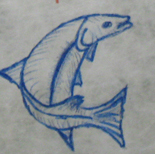Salmon

long forgotten, never known
all she knows is she must be there.
driven to a place
returning as ancestors before
generation after generation.
called home once more
alive – alert – swift
riding on her memories
ancient as time
is this what I feel
in my yearning?
my own bones knowing
an aching at times,
a body longing for home.
am I as the salmon,
pulled by ancient memories
calling me…
calling me home?
Poetry and Salmon drawing by Deanne
Fish, salmon in particular, are associated with knowledge. The child that grew to be called Taliesin, the wise magician, was found in a fish weir. The significance of the salmon can be seen in many places. Gwyrhr questioned a series of wise animals, each one wiser than the previous, the oldest and wisest of all was the salmon of Llyn Llyw. Cúchulainn used the hero's salmon leap across the Pupils' Bridge to get Scáthach's stronghold in order to gain access to Scáthach's advanced knowledge of arms.
To gain the secrets Cúchulainn had to use the hero's salmon leap to Scáthach herself in order to gain the secrets reserved for her family. Each leap in the land of sorcery brought Cúchulainn to greater knowledge. Their wisdom can also be passed on by eating. The magic salmon gain the power of wisdom by consuming the hazel nuts that drop into sacred springs. By symbolically eating the salmon of wisdom, Demne gained such enormous wisdom that he was renamed.
 Salmon are anadromous fish - they live in the sea but reproduce in fresh water (in a stream or lake). They are amazing fish that live in fresh water during their early life, mature in salt water, and then return to fresh water to breed (and then die). Some salmon (sockeye and chinooks) travel up to 1,000 miles (1,600 km) upstream in order to spawn.
Salmon are anadromous fish - they live in the sea but reproduce in fresh water (in a stream or lake). They are amazing fish that live in fresh water during their early life, mature in salt water, and then return to fresh water to breed (and then die). Some salmon (sockeye and chinooks) travel up to 1,000 miles (1,600 km) upstream in order to spawn.
Salmon live most of their life in the sea, but when they are mature and ready to breed, they enter fresh water to spawn (reproduce), traveling to a stream or pond high in oxygen. The female digs a nest in the gravel (called a redd) with her tail. She then pushes her thousands of eggs into the nest and the male milks the eggs, fertilizing them. Most salmon die after spawning.
The newly-emerged salmon (called alevins) still have a food sac attached to them. When the food sac is used up, the salmon fry emerges from the nest - and must find food (like insects) for the first time. As the fry matures, it becomes camouflaged (with parr marks) and is called parr . When it becomes silver-colored, it will be called a smolt. After growing for a while, the smolts swim downstream to the sea.
When smolt reach the estuary (where the river meets the sea), a process begins in which their body changes, allowing them to soon live in salt water (this is called smoltification).
The salmon lives in the sea until maturity (1 to 7 years, depending on the species); some migrate thousands of miles in the sea. They then return to the place where they hatched and continue the cycle. No one knows how salmon return home -perhaps they remember the distinctive set of smells along the way. On their journey home, they do not eat at all, they often change color, their muscles soften, and they will die soon after spawning.